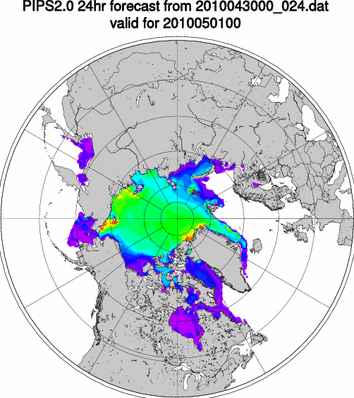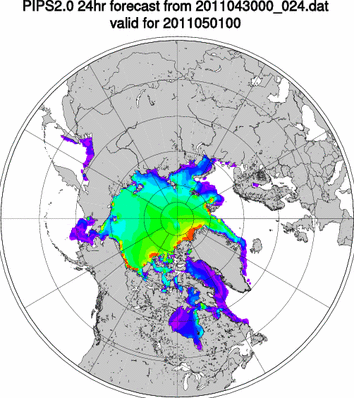The Alfred Wegener Institute for Polar and Ocean Research of the Helmholtz Association here reports that its Polar 5 research plane, loaded with measurement instruments, has just completed a 6-week expedition over the high Arctic, along with 2 other planes from the European and American space agencies ESA and NASA, to measure, among other things, the thickness of the ice.
On May 6 the Polar 5 Arctic expedition plane returned to Bremerhaven, Germany, where scientists will evaluate the volumes of data on sea ice, trace gases, aerosols and meteorological parameters that have been collected.
The Polar 5 route started in Barrow (Alaska) went over Inuvik, Resolute Bay, Eureka, Alert (all in North Canada), Station Nord (Greenland) and all the way to Longyearbyen at Spitzbergen. These locations were the base stations for the measurement flights over the uninhabited Arctic regions. The total flight time for measurement and travel was 130 hours. One of the main tasks was large-area sea ice thickness measurement in the inner Arctic, and this was done in close cooperation with the University of Alberta.
Preliminary results show thinner ice?
They used a four-metre long electromagnetic ice thickness probe, also called an EM-Bird. The Polar 5 towed the probe on an 80-meter long cable at a height of 15 meters over the ice surface. The AWI press release states:
A preliminary evaluation shows that one-year ice in the Beaufort Sea (north of Canada/Alaska ) is about 20-30 centimeters thinner this year than in the last 2 years. Ice thickness in 2009 was on average 1.7 meters, 2010 at 1.6 meters and 2011 at 1.4 meters. ‘I would expect this one-year thin sea ice will not survive the melt season this year“, estimates Dr. Stefan Hendricks. In a few weeks his colleagues at the sea ice group at the Alfred Wegener Institute will introduce their model calculations for the 2011 sea ice minimum.”
So the ice in the Beaufort Sea has gotten thinner? How does this assertion compare with PIPS, see here? Here are the PIPS ice thickness charts for the last three years, all for May 1st. Green is thicker and blue is thinner (see their site for the scale). For 2009:
and for 2010:
and for 2011:
Hmm. Clearly we see that somebody is overflowingly filled with crap. The charts show that Arctic sea ice is getting thicker.
So what is going on? We do know that the AWI is funded by the government, which happens not to be interested in any news that may suggest they have been going down the wrong path and living in a planet-rescue fantasy. No, the ice has to be getting thinner – even if it is getting thicker – and their masterminded plan to rush into renewable energy indeed is going to rescue the planet. The scientists were probably summoned by the Klimateburo and told to watch what they release to the public, or else get the big cut-off! Who knows.
In the meantime maybe we can find an explanation for the huge discrepancy.









Who is right?
Pierre, imho the ice is making a slow recovery and thickness of ice is definitely the key we’ll see towards the sept 2011 minimum.
Seeing as, we only have figures going back to 1979 for sea ice extent and that we ‘know’ [anecdotal evidence] the sea ice – has been less at times in recent C20th history, I really cannot see how any scientist should be getting too excited in the Wegener Institute.
Most figures suggest, the sea ice in the Arctic basin has been making a slow but significant recovery since 2007, lets us wait and see.
But then, this never was about science and we all know this! Alarmists must stay on message![arrgghh!]………They should look around though and realise most of the real world knows the truth – that: it ain’t all about MM CO2 e.
The realists main problem is [how to deprogram] dragging the politicians back into the real world – now, that’s gonna take some effort.
Comparing the May 1st charts over 2 years, I’d say the Arctic is recovering rapidly. Area is only one metric. But 2 years is also not a trend.
I want to agree with you there PG, indeed I think the older sea ice area remaining deepening and growing yr on yr – trend will continue.
I believe the sea ice to be ‘coming back’ but it is a slow process [mother earth don’t do quick]…..there are however – many variables…….we will see sir!
Since 2009 it is clearly not yet in a death spiral. We will have to wait for a few more years yet to see whether it has bottomed out or not.
Meant since 2007.
Do you mean that the government is fiddling the figures?
Well I never!
” ‘I would expect this one-year thin sea ice will not survive the melt season this year“, estimates Dr. Stefan Hendricks. ”
Well, duh. Every melt season most of the ice that melts is 1-year old ice.
“‘Snow supremo’ needed to avert winter transport chaos”
http://www.bbc.co.uk/news/business-13363738
“The UK should appoint a “snow supremo” to try to avoid another winter of chaos at airports, MPs have recommended.”
But in 2000 that Dr. Viner from CRU said snow would soon become a very rare and exciting event. Children aren’t going to know what snow is. I’m deeply dissapointed. :O(
Alfred Wegener who overturned consensus (with continental drift) and froze to death in Greenland must be spinning in his grave right now.
Since I was still being taught the pre continental drift consensus in primary school in the late 1960’s I can say consenses die only when buried at midnight with stakes in their hearts.
I almost never look TV anymore , but yesterday I turned on the eight o’ clock news. Very interesting item: our Prince William was concerned about melting arctic ice. ‘Is the ice melting?’, asked the reporter. ‘Well, not yet, but it may happen as the scientists told us’. This was very correct of him, of course: it may happen or it may not happen. And we also see what scientists are good for. In the same news was his wife, our future Princess or Queen, who declared that she regretted a remark of a few years ago, that ‘The Dutchman’ does not exist. That was a very correct remark again but, like Denmark, The Netherlands is becoming more and more xenophobic and populist. Poor Royal Family. For the news I do not need the TV neither.
I don’t have the time but work out the survey time for this latest series of measurements, and see what the space weather situation was.
I am in the mineral exploration business and EM birds are a routine tool we use to map the subsurface. I won’t go into the physics but interpretation of the data produced by these instruments, apart from the model assumptions these are designed on, are crucial parameters.
Doing EM surveys in the Arctic with a variable geomagnetic field, especially that is active, is not a useful thing to do.
The disparity between geophysical interpretation and physical reality is quite common in my area of professional experience – the geophysical conclusions are always explicable in hindsight, never the reverse.
Can you say, “Confirmation Bias”?